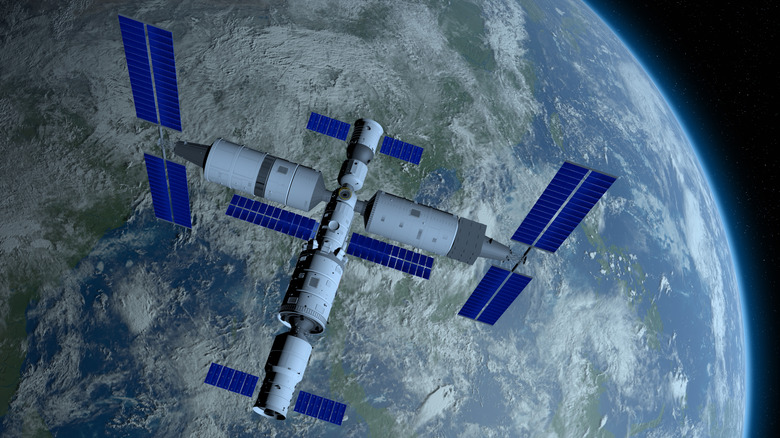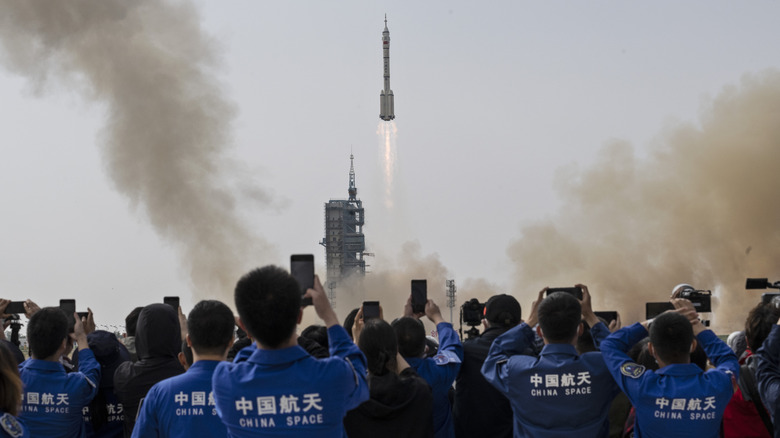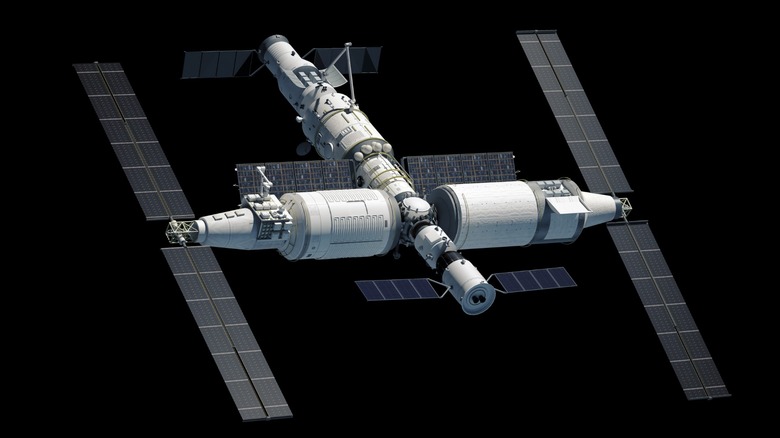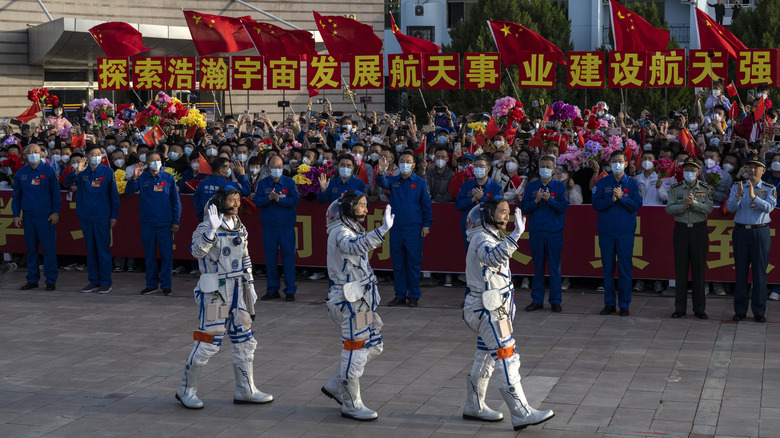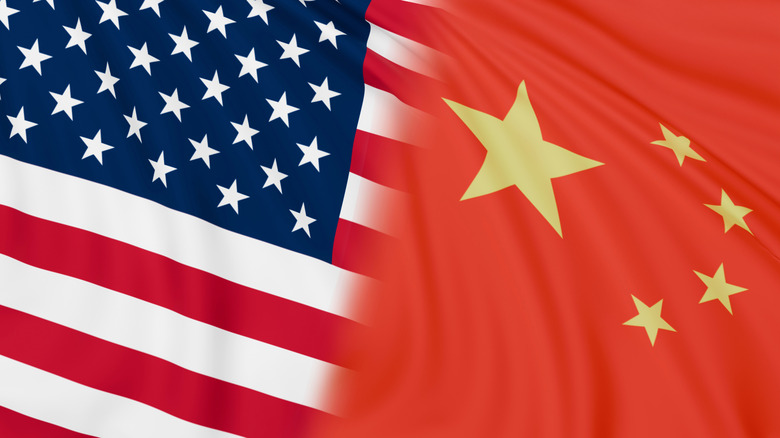What You Don't Know About China's Tiangong Space Station
You've heard of the International Space Station, but did you know it now has a neighbor? It turns out the "I" in ISS only goes so far, for while astronauts from 26 different nations have visited the station to date, one international superpower is notably absent. China operates its own, independent space station, called Tiangong, a name that means "heavenly palace." Built and maintained by the China Manned Space Agency (CMSA), Tiangong is still a relatively new presence in the skies, but it comes with major implications for the future of space exploration, and international relations.
Tiangong is very similar to the ISS in many of the most fundamental respects. It operates in low-earth orbit, between approximately 217 and 280 miles in altitude, roughly the same range as the ISS. Both stations move at similar speeds, making a full orbit of Earth every hour and a half. However, they have different orbital inclinations, keeping them safe from colliding with each other. On certain occasions, you can even spot the two stations in the sky at the same time, though this doesn't happen very often given their different trajectories.
Tiangong is manned by three taikonauts — the CMSA equivalent of NASA's astronauts — who spend six-month shifts aboard the station. However, that crew is set to grow in the future, along with the station as a whole, because China has big plans for its new orbital base. With the ISS set to be decommissioned at the end of 2030, could Tiangong become humanity's primary outpost in space?
The history of Tiangong space station
The current Tiangong station is actually the third spacecraft to bear that name. Previously, the China Manned Space Agency launched two smaller space labs, Tiangong 1 in 2011 and Tiangong 2 in 2016. Both labs were short-lived, with Tiangong 1 being decommissioned in 2018 and Tiangong 2 the following year, meeting their final fate upon reentering the atmosphere and breaking apart over the Pacific Ocean. Although they only hosted a few crewed missions, the first two Tiangong projects paved the way for the larger space station that now bears the name.
At this point, you may be wondering why China is investing in these projects rather than utilizing the existing International Space Station. This is where things get contentious. The ISS is cooperatively managed by the space agencies of the United States, Russia, Europe, Japan, and Canada, however, the U.S. generally wields the most influence over the station, having the largest space exploration budget, and having sent over 100 more astronauts there than any other country.
The U.S. government has made it a high priority to hide their technological achievements from China, and vice-versa, so cooperation between astronauts and taikonauts aboard the most expensive piece of technology ever created would understandably be difficult. In 2011, the U.S. passed a piece of legislation called the Wolf Amendment, which prohibits the use of NASA funds in cooperation with China, effectively banning China from the ISS. Without access to the existing space station, the Chinese government pivoted to building their own.
How Tiangong compares to the ISS
Tiangong space station currently consists of three modules connected in a T formation. The central module, called Tianhe, which means "harmony of the heavens," was launched in April of 2021, marking the first stage of the station's assembly. Two laboratory modules, named Wentian and Mengtian ("quest for the heavens" and "dreaming of the heavens," respectively), were added the following year. Mengtian has an airlock and robotic arm for extravehicular experiments.
The taikonauts' living quarters are located in the Tianhe module, which is equipped with life support systems, such as a filtration system that converts urine into drinkable water. Tianhe also has a docking port for Shenzhou, the spacecraft that transports taikonauts to and from the station. The central module has also been noted for having very spacious conditions by spacecraft standards, especially when compared to the previous two Tiangong space labs.
For now, the most notable difference between Tiangong and the ISS is that Tiangong is significantly smaller. The ISS has 16 modules to Tiangong's three, and hosts an average crew size of seven. Tiangong is roughly half the length of the ISS, and is far lighter, with only a fifth as much mass. However, being newer than the ISS, Tiangong boasts more up-to-date technology, most notably a pair of solar power arrays that can be steered to optimize solar exposure and store energy for the period of orbit when Earth blocks the ISS from the sun. This is a more efficient method than the ISS's large collection of stationary solar arrays.
What are China's goals for Tiangong?
The China Manned Space Agency has ambitious plans for Tiangong's future. Three additional modules are in the works, which would expand the station's capacity to seven astronauts, on par with the ISS. Several research projects are also coming to Tiangong, the most exciting of which is the space telescope Xuntian (meaning "survey of the heavens"), intended to transcend the James Webb and Hubble telescopes. Xuntian could launch as soon as 2026, and it will orbit alongside Tiangong. The space station will thereby serve as a base for maintaining and upgrading the telescope.
Tiangong fits within China's broader space agenda, which includes putting a taikonaut on the moon in 2030. With Tiangong as its base, CMSA looks to establish itself as a preeminent space power, and the Chinese government is now pursuing collaborative partnerships with other countries. It has already announced that Pakistan will be the next nation to get a foot aboard Tiangong in 2026.
Tiangong's rise comes as the ISS is set to be decommissioned in 2030. NASA has already announced that it will not manage an ISS replacement, planning to turn responsibilities over to a private company. With the future of America's presence in space seemingly up in the air, China may aim to make Tiangong the international hub of cosmic science. However, Tiangong won't live forever either, and as of now, it's only expected to operate for 15 years. It's uncertain where an ISS replacement will stand at that point, or what China's plans post-Tiangong are.
Are the U.S. and China in a space race?
With the launch of Tiangong, China has become just the third nation in history to have built its own space station, following the United States and Russia (formerly the Soviet Union). This comes with major implications for scientific research, but perhaps more pressingly, international relations, with some raising concerns that Tiangong represents the start of a new space race between the two most powerful countries of the moment.
The term "Space Race" came to prominence in the 1960s when the U.S. and Soviet Union were engaged in an arms race that ultimately turned into a race to put humans in space. This led to the Apollo moon missions, and the main reason we haven't gone back to the moon since the 1970s is that the space race was considered over. However, the U.S. is now making more aggressive moves in space exploration, with NASA's Artemis program pushing towards a return to the moon ahead of China's planned mission. In some ways, it does feel like a callback to the competition of the past, but declaring a new space race is a premature move.
China still lags behind the U.S. in virtually all facets of space exploration, with significantly fewer astronauts and satellites in orbit. China also invests far less money in space exploration annually than the U.S. does. However, the Chinese investment is growing steadily, and by the time the ISS is decommissioned, the story might be different.
